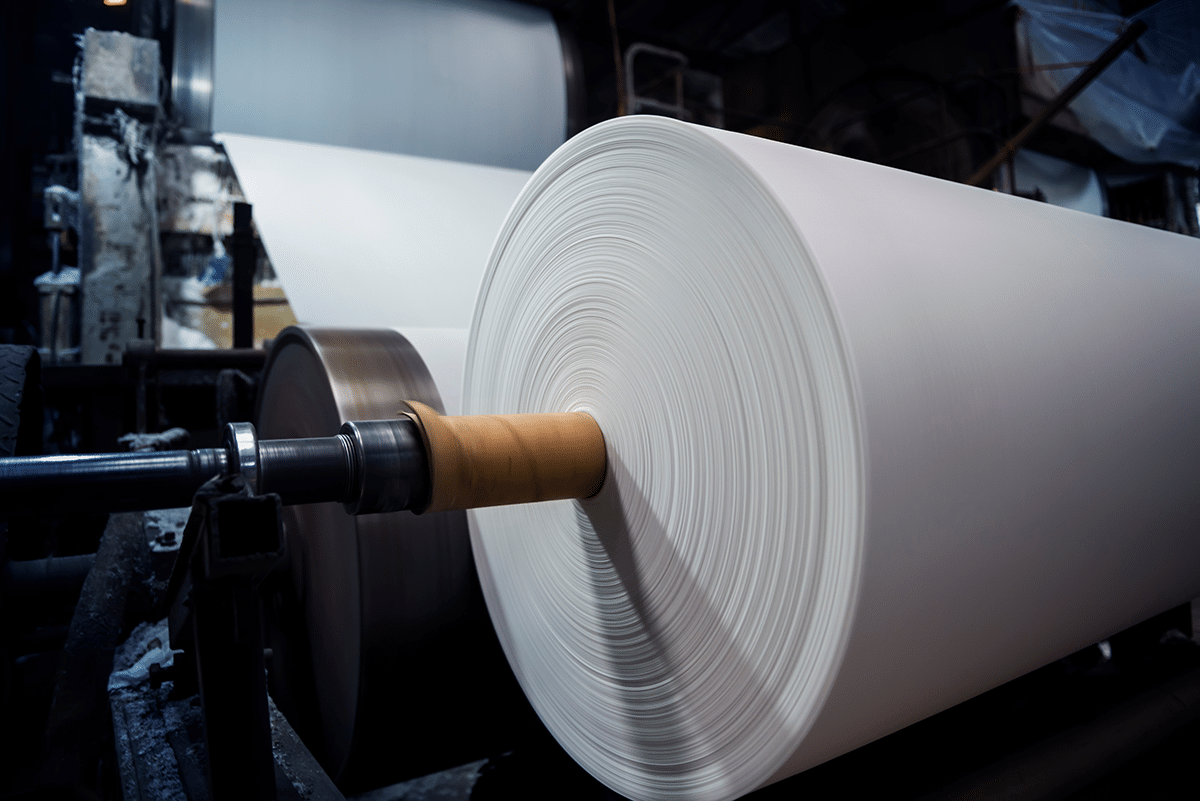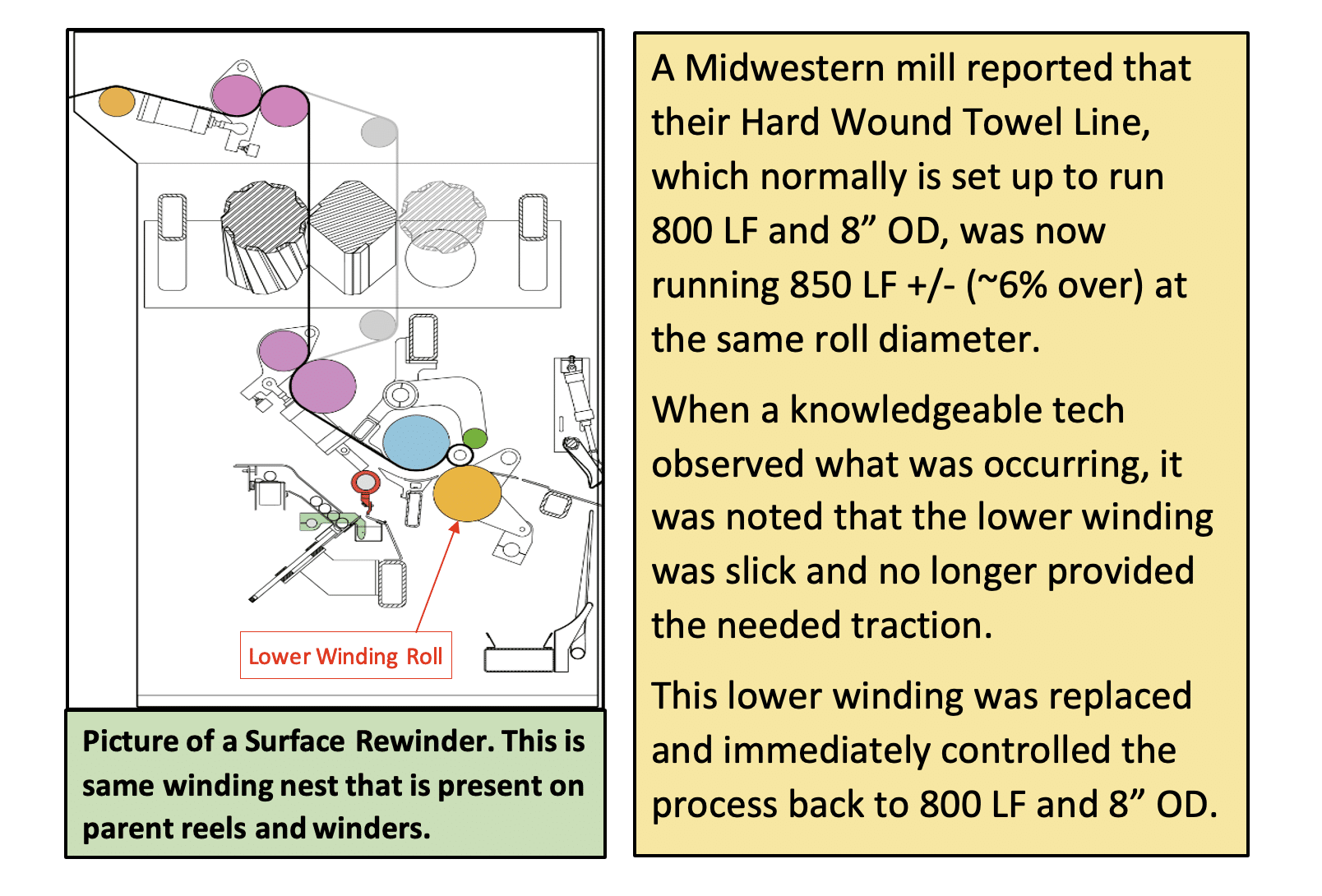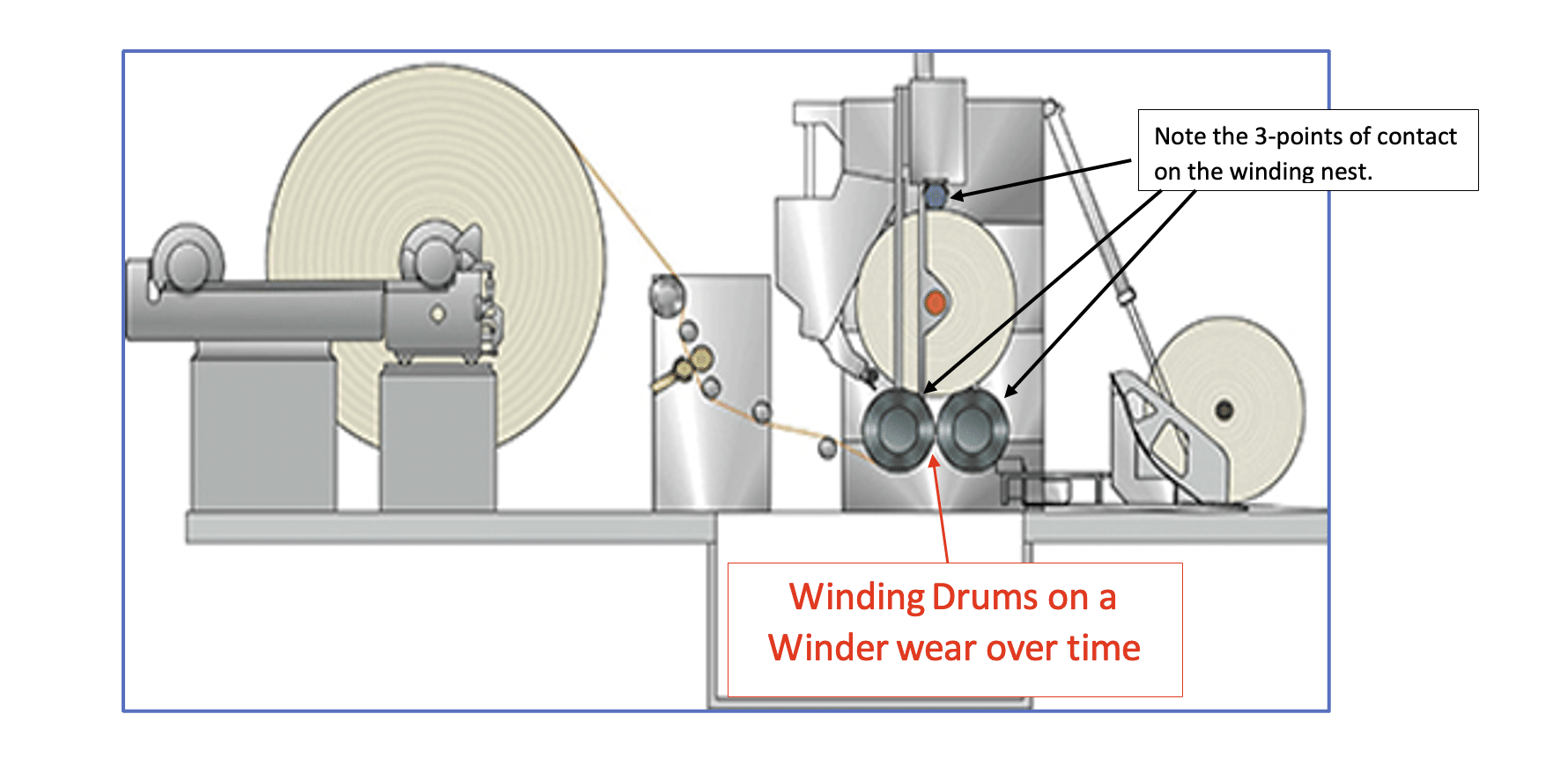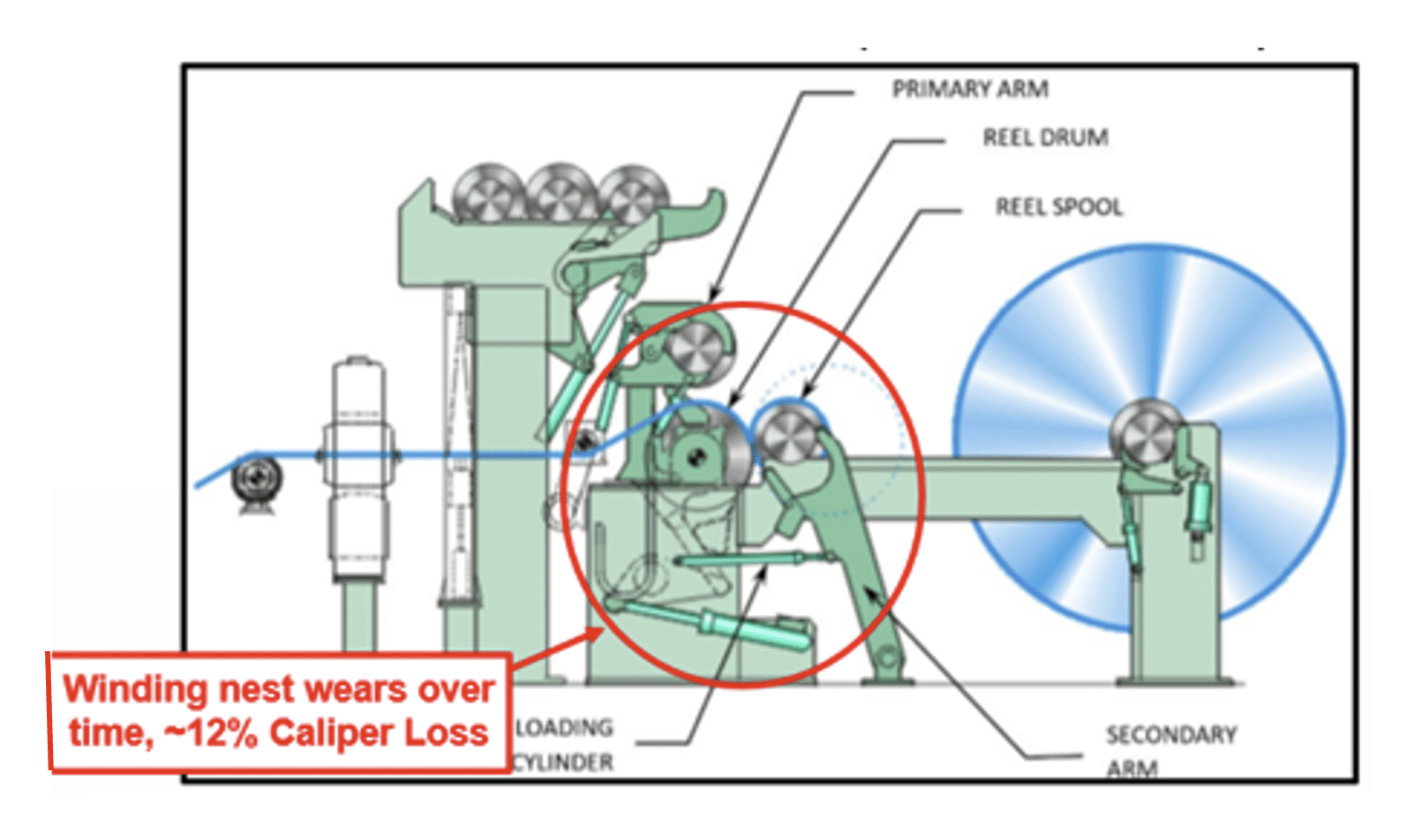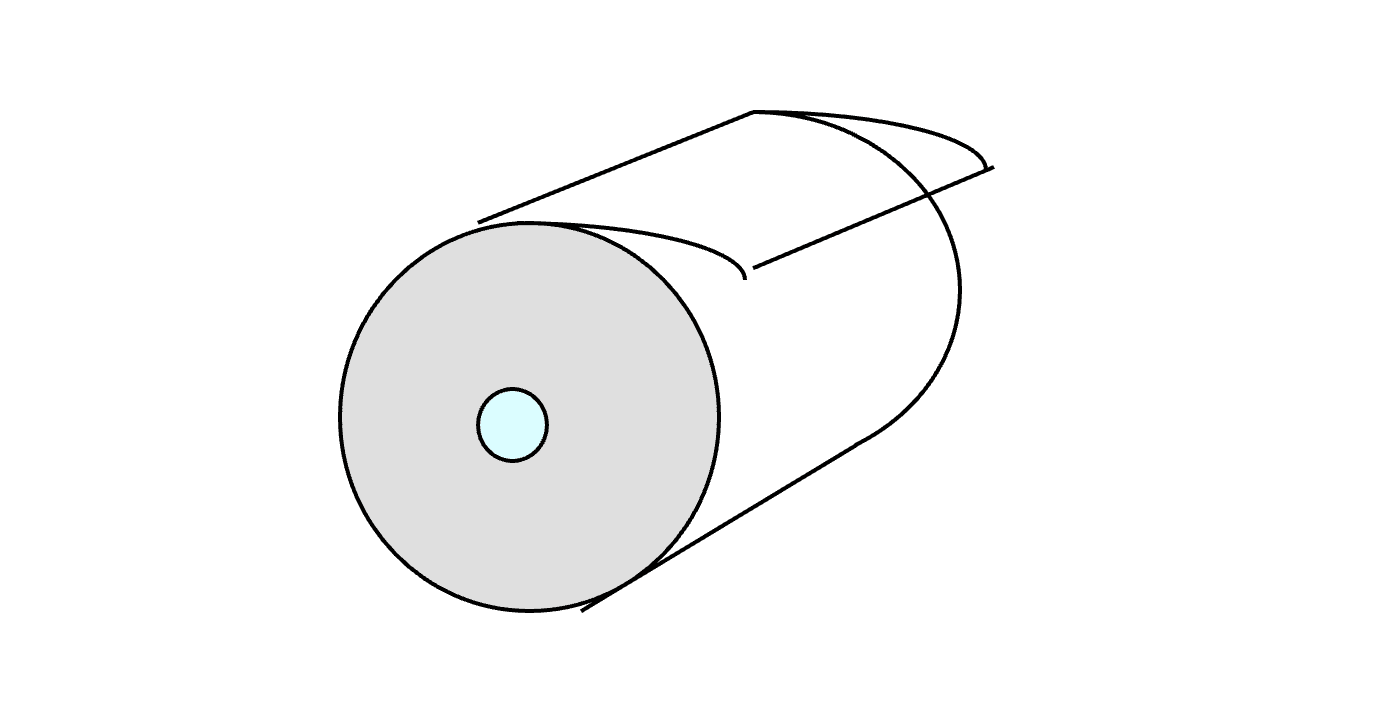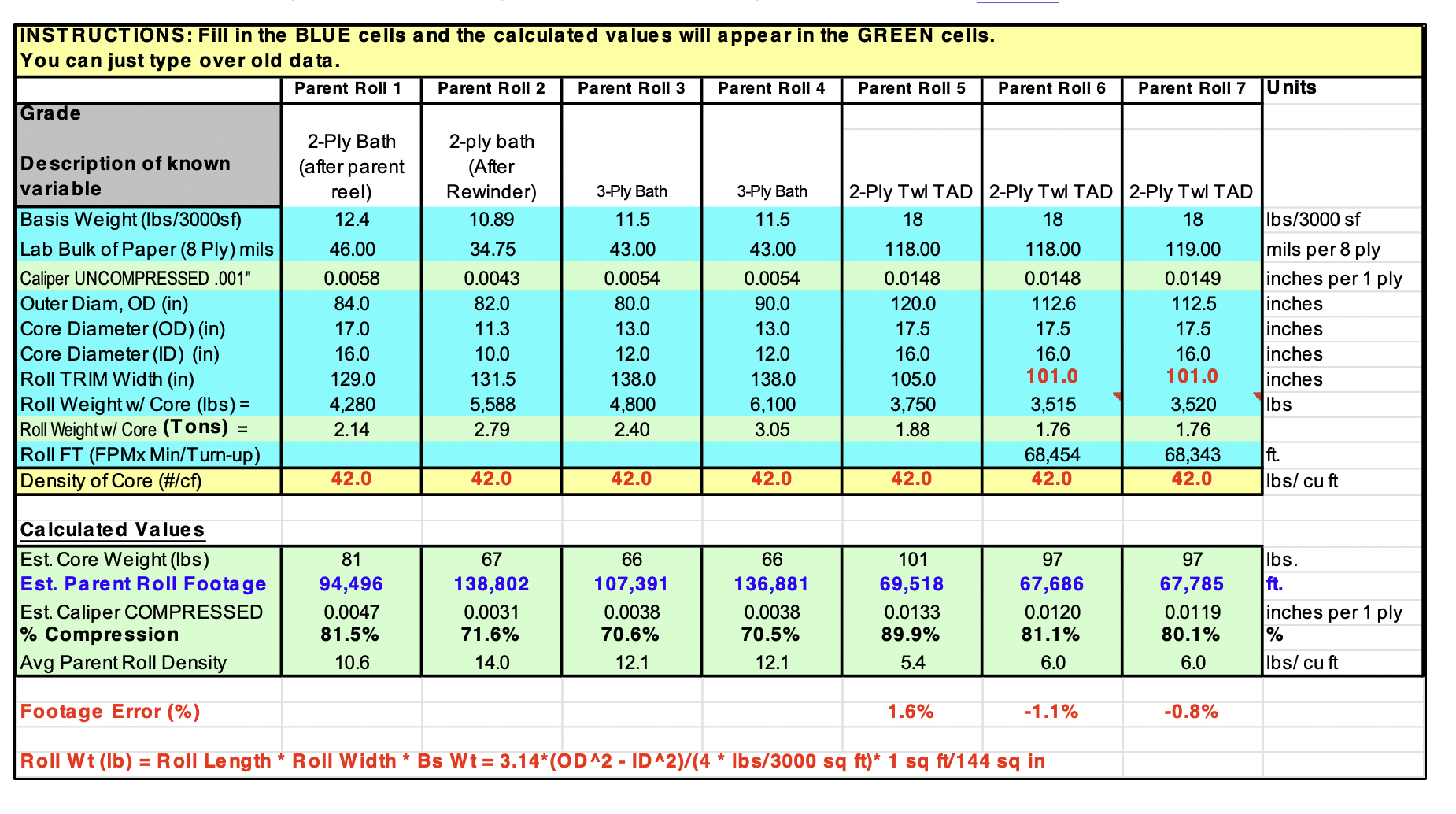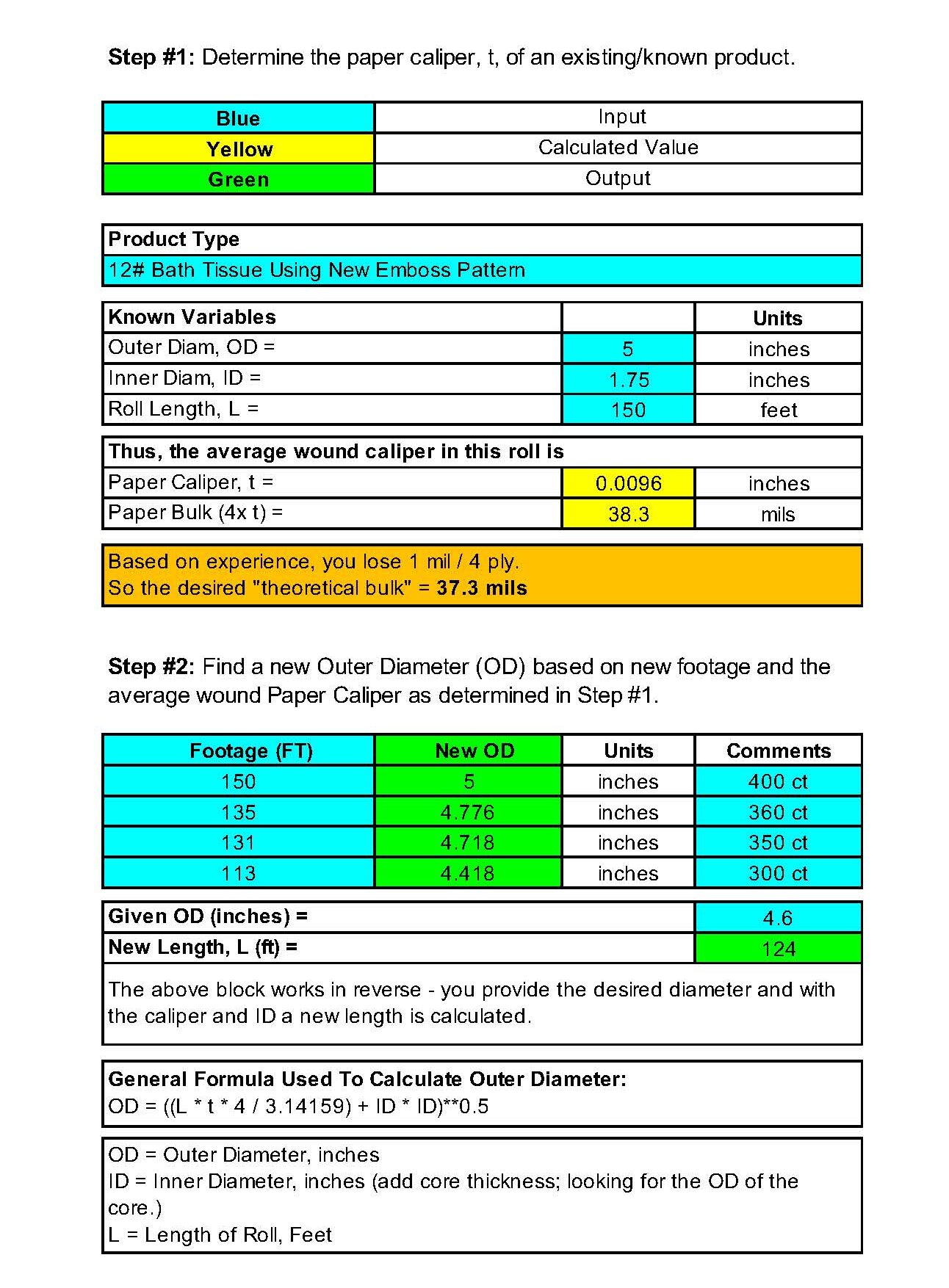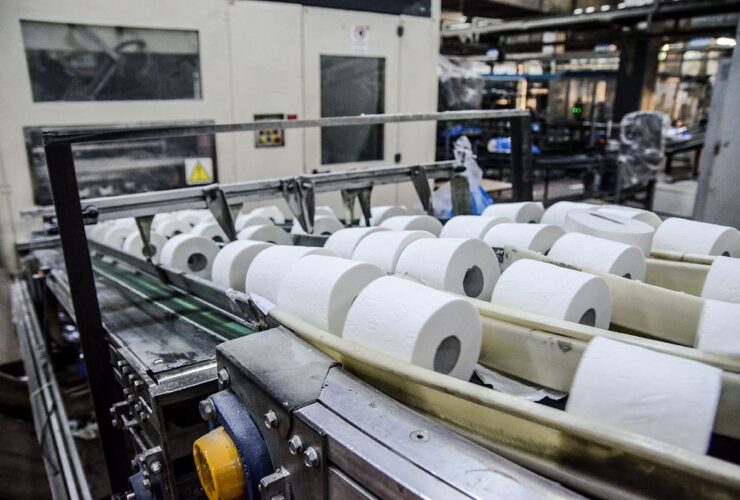Due to their high stretch, tissue products have the most compressibility of all paper products. In many instances, few firms recognize that over-sheeting is occurring. Learn best practices and ways to monitor and control this within your process across pulping, paper machines, winders, and converting.
Step 1 – Gather Data
This is best completed by forming a team (QC, Engineering, Manufacturing, IT, etc.) to gather and analyze the data.
- Surprisingly, data gathering can be difficult.
- Quality Controls Systems, where this would be tracked and reported, are typically home-grown systems not connected with other reporting systems. Expect to find a bunch of paper data or Excel spreadsheets.
- A key to long-term success will be to automate gathering the QC Data and integrating this into other manufacturing systems, such as a Specs software product, which contains all of the key parameters such as Bs Wt., MDT, CDT, Stretch, TEA, Footage, Roll Diameter, Case Dimensions, Grade data for Converting, what PM and its specifications have been approved on and so forth. To automate this process, consider inside technical support or outside firms that can help systematize this process.
Step 2 – Analyze the Data
- Likely, QC will report data on several products that have been overcounted for months, if not years. If you want to sabotage the process and get upset with the messenger, they will quickly revert to clamming up. Remember you are here to learn and fix the long-term problem, not get upset with messenger.
- Where will the likely candidates be? Surprisingly, it occurs in both Retail and Away-from-Home (AfH) roll products almost equally.
- Retail Bath – Both high and low-count bath
- Retail Towel – Both high and low-count toweling
- AfH – Jumbo Roll Bath, 9” OD (1,000 LF) and 12” OD (2,000 LF)
- AfH – Hard Wound Towels 400 LF, 600 LF, 800 LF, 1000 LF
- AfH – Single roll, wrapped and unwrapped bath with varying sheet counts.
- Troubleshooting the issue. There can be several potential causes, but I would recommend reviewing the following in this order:
- Most of these issues are rolled products with specific sheet counts expected to be adhered to. That means each product will have a particular core (Inner Diameter, ID), a target Outer Diameter (OD), and a defined Sheet Count.
- All rolled products are centered around a specific Outer Diameter (OD.) Why? All equipment after the rewinder (where the roll products are formed), rely on a firm and consistent roll diameter. If the OD is too small, the log saw clamps will not allow the clamps and pusher to keep the cut-off roll width the same. This causes another issue where say, one roll is 4.25” and the next is 3.75” with the width spec being 4.0” OD. Then the wrapper cannot work correctly as well as the case packer. If rolled products are loose fitting in the case (kdf) when the OD is undersized, this causes case handling, storage issues, and crushed case concerns.
- When low OD Rolls are noted, the rewinder operator typically will add sheets to build up the roll diameter. This can vary, but suffice it to say that the operator will nudge the count upwards until the downstream equipment of log saws, wrappers, and case packers/bundlers are satisfied. And when that doesn’t work, they ask that the PM grade increase caliper, basis weight, or both.
- Troubleshooting: Start with converting. Just as with a Paper Machine, Winder, and a Converting Rewinder, all have critically important 3-points of contact when winding a roll. Here is a typical surface rewinder to help understand this concept.
Remember that paper is abrasive.
When OEMs designed their equipment (Be that on a PM, Winder, or Converting), they designed their equipment with a certain level of texture or “grip” to provide the needed traction to control the process. But this wears off over time and needs to be replaced. It is critically important that you understand this concept. An analogy would be driving a car with slick, worn-out tires. There is no traction. This same principle applies throughout Paper Machines, Winders, and Converting.
Coating is recommended for the Lower Winding Roll in Converting
- 700 – 800 Ra (Average Roughness) Surface Finish [Think of this as an 80-grit sandpaper finish]
- 005” to 0.007” Coating Thickness (Silver Color) [Expected to last 3 to 4 years.]
- Composite Coating that combines benefits of a hard coating with a special release element that is impregnated into the surface. This release agent basically keeps dust and adhesives from sticking to the coated roll.
As you move upstream from Converting, two processes are known to crush caliper. These are Parent Reels at the end of a paper machine and Winders, where used.
- Do we have any estimates on how much a traditional parent reel reduces caliper?
- Do we have any guesses on how much a traditional winder reduces caliper?
Winders often slit parent reels down to needed widths for converting.
This would be used for tissue products to slit parent rolls to fit converting unwind stands. This could be used to two-ply bath tissue, slit napkin grades to needed widths, or to add plies to napkin rolls for 2 or 3-ply napkin production. Generally, caliper loss is approximately 10% on a winder. And that is when the rollers function well from textured rollers. Caliper loss can jump to as high as 16% if not monitored. If the winding drums are slick and shiny, that is not good. It’s time to send out the winding drums to get them recoated. Note that depending on the firm employed, they can perform that service directly on-site or turn it around overnight.
Paper Machine’s Parent Reel
Just like on the rewinder in Converting, expect the Parent Reel to have caliper loss. On average, this is noted as a 12% caliper loss. But that again is when everything is set up to factory specs, has good traction on affected rollers, and the primary and secondary arms are not adding excessive force in the winding nest. The key point is that in some instances, with high-stretch tissue paper, loss of traction on key rollers, and excessive pressure from the primary and secondary arms, this can jump to 16% to 20% caliper loss.
Another mindset is that PM operators believe that placing more paper on a parent roll benefits those running converting lines. The thinking is that packing more footage on the parent reel will be fewer parent roll changes needed in converting. It also allows the PM operators another ~5 minutes between roll turn-ups.
Unfortunately, this caliper loss leads to over-sheeting even if all the rolls in converting, such as the lower winding roll, are in great shape and have the appropriate grip/texture applied.
Just like in Converting and on Winders, it is critical to maintain the effective winding nest on all rollers that touch the paper. Yes, this gets more complicated with the primary and secondary arms and the amount of pressure that can be applied to the web and parent reel as it is wound.
Best Practices – Best practice calls for each paper grade off a paper machine to have a target for:
Roll Footage: Outer Diameter; Inner Diameter; Bs Wt., MD Tensile, CD Tensile, Stretch, Water Absorbency, Trim width, Caliper, Bulk, and depending on the grade, Softness Levels and Furnish (HW / SW / Broke)
Roll footage was placed first to add emphasis to this discussion. Many firms do not measure this, and as the adage goes, what gets measured gets controlled. The tendency is to run to a roll diameter, and unless QC measures something out of spec, it is approved and sent into parent roll storage. My first encounter wasn’t over sheeting, but under sheeting. The 2-ply JRBT was 950 LF vs. 1,000 LF. Both under and over-sheeting are related.
To capture Roll Footage on a PM or Winder, roll footage can be added as part of the QCS reading or a separate instrument can be used to measure footage and attached to the Roll Number. When this is not available, then you will need to calculate the footage based on the following:
General Formulas Used In Calculations:
General Formulas Used In Calculations:
Area = Length x thickness = 3.14 x (OD2 – ID2)/4
Est. Core Weight (LBS)= (3.14/4) x (Core OD2 – Core ID2) x (Trim Width) x (Core Density) (Core density = 42#/CF)
Est. Parent Roll Footage, L for Length (FT) = (Roll Wt. w/ core – Core Wt.) (12”/ft x 3000 sf)/ (Bs Wt. x Trim Width)
Est. Caliper COMPRESSED (inches) = (3.14) (Core OD2 – Core ID2) / (4 * Est. Roll Footage x 12)
Variables:
OD = Outer Diameter, inches
ID = Inner Diameter, inches (add core thickness; looking for the OD of the core.)
L = Length of Roll, Feet
t = Thickness or Avg. Wound Caliper, inches
Calculations can be placed into a Spreadsheet to help minimize the effort
These same equations allow you to determine a new Roll Diameter by calculating the current Average Wound Caliper and then projecting the new Roll Diameter for a different count. This can be used for all finished product tissue grades.
Legal Requirements
Tissue products sold in the United States fall under the Fair Packaging and Labeling Act: (eCFR :: 16 CFR Part 500 — Regulations Under Section 4 of the Fair Packaging and Labeling Act) Regulations Under Section 4 of the Fair Packaging and Labeling Act. Basic Requirements: The FPLA requires each package of household “consumer commodities” that is included in the coverage of the FPLA to bear a label on which there is:
- A statement identifying the commodity, e.g., detergent, sponges, etc.
- The name and place of business of the manufacturer, packer, or distributor
- The net quantity of contents in terms of weight, measure, or numerical count (measurement must be in both metric and inch/pound units).
Purpose of the Act: The FPLA is designed to facilitate value comparisons and to prevent unfair or deceptive packaging and labeling of many household “consumer commodities.”
The key point is that Tissue Products must comply with a + / – 3% on content on an individual product and that when viewed as a unit sold to the public (e.g., case or bundle) it must meet the declared content.
Key Take-Aways on Over sheeting:
- Advise forming a team of Process Engineering, QC, Accounting, Converting S/I, and possibly Corporate. This over-sheeting challenge is typically found in most tissue facilities that use conventional paper. This is less of an issue on Thru-Air-Dried (TAD) paper due to equipment designed to protect the caliper throughout the process.
- Review QC data on actual footage and compare those to manufacturing specs for each product.
- Tabulate the differences and have the accounting person define the value once detected.
- In most instances, that value, even for just one location, will be high!
- With a list of SKUs and their over-sheeting values, go after the greatest value back to the company first.
- For each SKU, determine where the likely root cause is occurring.
For Converting
- Determine if the cause is lost texture/grip from the 3 points of contact in the winding nest of the rewinder. This occurs on both surface and center wound rewinders.
- Review the effects of the embossing. If the rubber roll is worn, that can lower the caliper/bulk going into the rewinder. For instance, if a rubber-to-steel engraved roll is used, is it time to replace the rubber roll?
- Check the tension. Some grades, like hard wound towels, can have very high tensions. This of course pulls out stretch, caliper, and basis weight slightly, resulting in lower caliper going to the rewinder.
- Review past data. When did over-sheeting occur? Were changes made in the base sheet that affected the caliper?
For Paper Machines
- Is this same grade made on multiple PMs?
- How much variation is there within the same grade but from different PMs?
- Ask that all PM grades start deploying Roll Footage as an essential criterion. This will take time, but it is an important first step. Start with the highest over-sheeting SKU first.
- If over-sheeting occurs in Converting, modify specs off the PM or Winder.
- Start by mapping out Targets and Ranges on Roll Footage, QC Lab Caliper (1-ply) / Bulk (8-ply), and determine the results in converting.
- Remember that this is a process and doesn’t happen overnight. Showing steady gains that reduce over sheeting will quickly hit your facility’s bottom line.
- “Knowledge Share” your learnings with other facilities. Yes, we all know how competitive we can be between mills, but that is how progress is made.
- Remember that, on average, parent reels lose 12% of the caliper. I’d recommend mapping out what each PM’s caliper loss is. That also includes the average wound caliper and roll density. The tighter the tension within the parent roll, the greater the loss of the average wound caliper. Remember that tissue products have the most stretch of any paper grade. The longer the parent roll sits in storage, the greater the caliper loss can occur.
- Roll density is often cited in textbooks and can often be used to discuss variations between PMs and Grades (e.g., Tissue vs. Towel Grades vs. Napkin Grades.) This is another important step to develop. This is often used to discuss how much caliper loss / higher density occurs off each paper machine.
- Tuning the Primary and Secondary Arms. Most will not pursue this because you must understand the controls to effectively tune each parent reel’s winding nest. However, there is a huge benefit that can improve the winding cycle and make successful web transfers to the next reel. Issues not commonly understood are parent roll spools that can differ in weight. That means that if no RFID chip is attached to each spool to know the actual weight, you cannot accelerate that spool to match the speed properly. And we all know what happens next. The web won’t transfer, and you have a blowout at the reel.
For Winders
- Yes, I know that some call PM “Winders” called “Rewinders,” and some call Converting “Winders,” is also called “Rewinders.” So, bear with me on nomenclature differences between manufacturers.
- Follow the same steps for Parent Reels on Paper Machines. Remember that on average you will lose approximately 10% of the caliper going thru a “winder.” That generally is a best-case scenario. Many are much higher caliper loss.
- Like PM Reel Sections, check for bright and shiny rolls. That is an immediate sign that you are reducing the caliper just like the converting “lower winder roll,” where we lost 6% in over-sheeting. Restated, instead of an 800 LF towel, it came in as 850 LF or roughly 6%. So that “10%” caliper loss is probably closer to 16% on the winder and 18% on the Parent Reel!
Conclusion
Remember to think through the process and all of the crush points that can occur. This may take you back to the pulp mill.
- Pulp Mill – Consider altering the HW / SW ratio. We know that Hard Woods generally provide more bulk but less strength. To understand what the current spec is and what options are available.
- Paper Machine – Several crush points are too numerous to get into detail. But consider the shoe press loading on the Yankee and creping harder to generate more calipers.
- Most Bath Grades will get calendered to improve surface hand feel. Can backing off calendering help?
- Parent Reel
- Look at the winding nest for mechanical concerns on proper traction.
- Review Primary Arm, Secondary Arms, and Rider Roll compression on the web.
- Establish Roll Footage as a Key Measurement Parameter. This process change/emphasis will sometimes allow changing the finished product specs closer to TAD products. We all know that TAD products have significantly more caliper/loft on a pure basis weight per ream. Imagine capturing 10% of the caliper so that you can reduce your footage and maintain roll firmness and loft.

